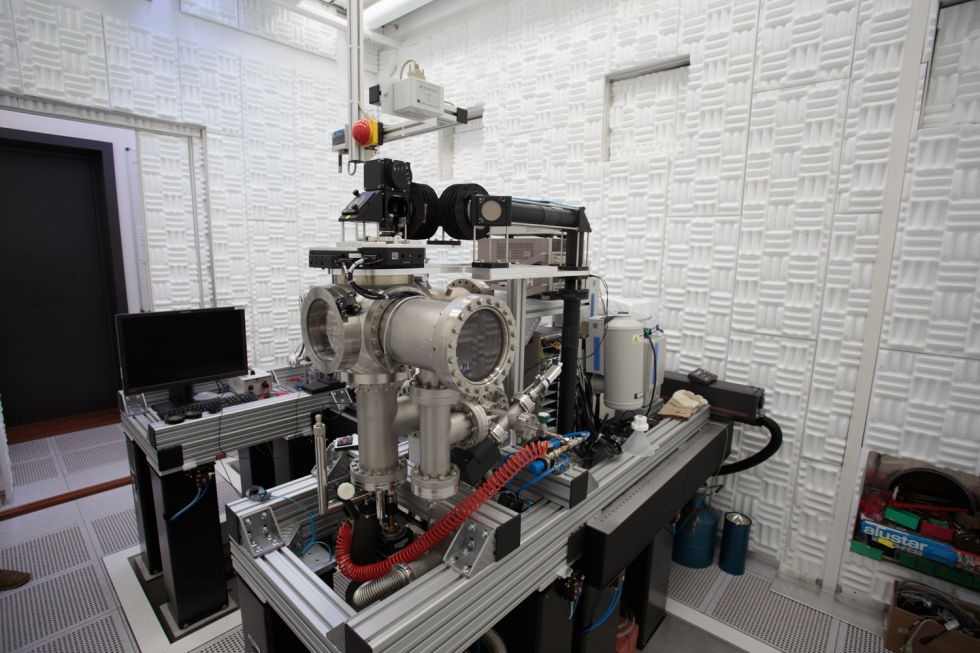The quietest rooms in the world: IBM laboratories in Zurich

A few minutes drive from the center of Zurich is a very interesting object - the IBM research laboratory, located deep underground, in the rocks. This is one of the most high-tech laboratories in the world, which, moreover, is the most quiet place in the world. There is no vibration, but there is protection from electromagnetic radiation. And here it is cool and quiet.
When you are going to conduct experiments at the atomic level — for example, to take a single atom and move it to the other end of the molecule, incredibly accurate equipment is required in such an experiment. However, to use such equipment will not work without an appropriate high-tech environment. In addition, when conducting experiments at the subatomic level, confidence is needed that external factors do not interfere with work. For example, the slightest vibration can lead to the fact that the snapshot of the molecule will be spoiled - nothing can be disassembled on it. Plus, you need a certain temperature.
The ideal solution is to create a bunker deep underground, and every detail of the project to create such a bunker will meet the main task - to isolate the room from the outside world. This is exactly what IBM has done in 2011 by opening the Binnig and Rohrer Nanotechnology Center .
The creation of the center cost the company about $ 90 million, this amount included equipment worth $ 30 million.
Equipment safe haven
')
Under the laboratory, at a great depth there are six quiet rooms - or, more precisely, rooms where there are practically no sounds. Here, as mentioned above, there are no vibrations and no electromagnetic radiation penetrating from the outside. Each room is used for a specific type of work. For example, in the same room, with a Raman microscope, fingerprints are taken from molecules. In the other, electron beams are used instead of visible radiation to obtain images of objects as small as 0.09 nm.
There are no vibrations here due to the large depth of the rooms, plus the rooms are carved into the rock. The walls of all rooms are covered with an iron-nickel alloy blocking practically all electromagnetic fields, including those generated by the equipment of the adjacent rooms. Each room is divided into two parts: a small room in which the experimenter is located, and the rest with equipment. Man is a source of heat, noise and vibrations, so it must be kept in isolation from equipment.

In order to further isolate a person, there are two sexes in each room - one suspended one, in which a person walks. And the other - the usual, it is the equipment. As for the second - this is, in fact, not the floor. This is a giant concrete slab weighing 68 tons, which is located on the air gap. Any vibrations are leveled by this layer.
And that is not all. To reduce the impact of acoustic effects, the walls are covered with a special material, an acoustic absorbent. Moreover, if the experiment uses more or less noisy equipment (vacuum pumps, for example), they are located separately from the rest of the equipment.
All rooms are illuminated by LEDs operating on direct current, the source of which is also located at a distance, eliminating the appearance of electromagnetic interference. In each room there are Helmholtz Rings, oriented in such a way that such a system covers the X, Y, Z axes. This is a great way to reduce the effects of residual magnetic fields.
Indoor conditions
The temperature here is about 21 degrees Celsius, the maximum temperature fluctuations - 0.01 degrees per hour. Maximum fluctuations per day - 0.03 degrees.
Electromagnetic fields from AC sources - only 3 nT, from DC sources - 20 nT.
As for vibration, the equipment installed on a concrete platform moves at 300 nm / s at 1 Hz, or 10 nm / s for 100 Hz.
Most of the problems - from acoustic waves. Despite the wall coverings, all other protective measures, there are sounds here. This is the noise of working scientific equipment, and a slight noise of ventilation, and some other sounds. The power is about 30 dB, sometimes lower, up to 21 dB, if the experiment is not very noisy.

Previously, the equipment installed now in the indicated rooms worked in the basement of the main room, on a conventional concrete floor. After all the instruments and equipment were placed in the rocks, the accuracy of the equipment increased by 2-3 times.
And before that, researchers had to work in their laboratories, under normal conditions. In this case, the bulk of the experiments were carried out at night, when the vibrations / noises are minimal.
Now scientists are very satisfied - they do not have to work on the night shift just because cars are driving along the roads during the day, and people are walking along the sidewalks.
Source: https://habr.com/ru/post/366017/
All Articles